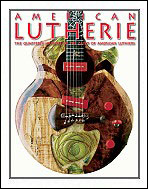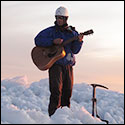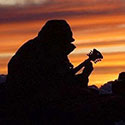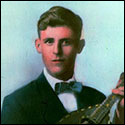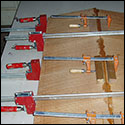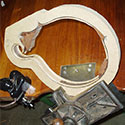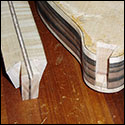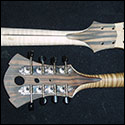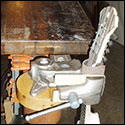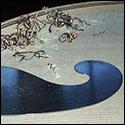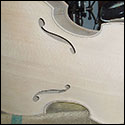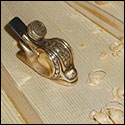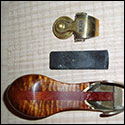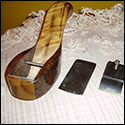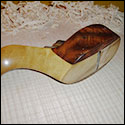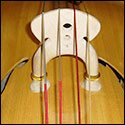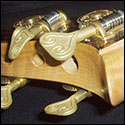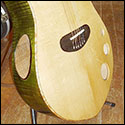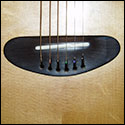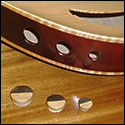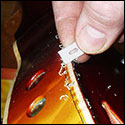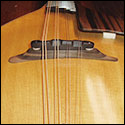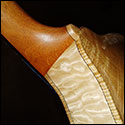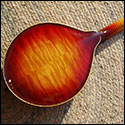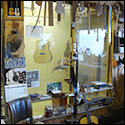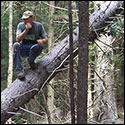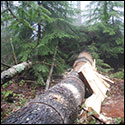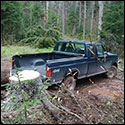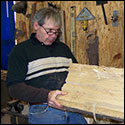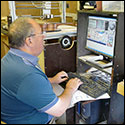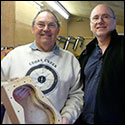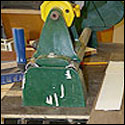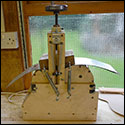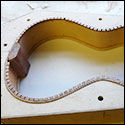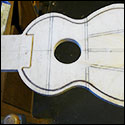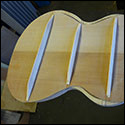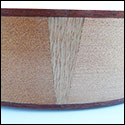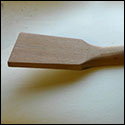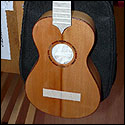|
|||||||||||||||||||||||||
Page 16 - Meet the Maker: James Condino by Roger Alan Skipper
|
|||||||||||||||||||||||||
Page 24 - Finding Your Voice by Dana Bourgeois from his 2008 GAL Convention workshop pg 25, I want to get nice clear musical responses holding and tapping in a number of different locations. (tapping) Can you hear those different pitches? There’s a sort of musical sound. (audio clip 1) pg 26, Audience: Could you demonstrate once more, but hold the top so that we can see the braces, and tap on the brace side? (audio clip 2) pg 27, (Again tapping, but this time in his accustomed way.) That’s the same brace, but the response is different (Photo 5).(audio clip 3) pg 27, I’ll do a little tapping again on a top that’s been voiced. (audio clip 4) pg 27, Now I’m going to tap one of these other tops using the same holding locations so you get a sense of where the differences are. (audio clip 5) pg 28, OK, I’ve whacked off enough wood that this should have changed. (audio clip 6) pg 29, So I’ve trimmed the ends, and I’ve made the braces more triangular, and I’m getting a little more flexibility side-to-side. (tapping) Listen to the difference. There’s a chord there. (audio clip 7) pg 29, This has still got a ways to go, but it’s not as bright as it was before. We’re getting into the flexibility range that’s kind of nice for this guitar. Let me just make a comparison with the top that is 80% finished. (audio clip 8) pg 30, The tones are coming down a little. That’s all on the same brace. Holding and tapping in the same places, where I was getting muffled response before, I’m actually getting some tone now. (audio clip 9) pg 30, OK, I’ve got good flex here. (tapping) The antinodes are moving around a little bit, but we are getting a clear low. Hear how long that lasts? That’s the lowest one so far. And these other tones are sounding full and musical. (audio clip 10) pg 30, OK, I’m getting some good flexibility, so let’s see what we sound like. (tapping) I’m trying to find nodes where I can hold it, and I will mark them so that you can try it. (tapping) There’s one. That’s nice. (tapping) That’s a nice one. (tapping) There’s my “bong” sound. There’s three good holding points. (audio clip 11) pg 30, ...Number 1 is the one that I did back in the shop; Number 2 is the one that I’ve done right now; and Number 3 is the unfinished one just for reference. Let me tap Number 3 again to give you a sense of where we’ve come from. (tapping) There are some musical tones there, but there are also some that are kind of clunky, and it’s way too stiff. |
|||||||||||||||||||||||||
Page 32 - Meet the Maker: Ron Sharp by David Miracle
|
|||||||||||||||||||||||||
Page 42 - Modern Meets Traditional in the Olympic Uke by Thomas Johnson and Ray Cowell
|
|||||||||||||||||||||||||
Page 46 - Magnetic Pickups and the Electric Violin by John W. Silzel The following mp3 format audio files are provided for readers interested in hearing the effects and waveforms described in the above article. This stereo audio clip demonstrates the tendency of a bowed violin E string to vibrate in the “X” plane which contains the bow hair and string. The “X” direction sensing pickup is recorded in the right audio channel of this clip, and the string’s motion in the “Y” direction (perpendicular to the top plate of the instrument) is recorded in the left audio channel. Both waveforms are proportional to the velocity of the string in these directions. When the string is being bowed, the output is predominantly heard in the right channel. When the bow is lifted, however, the string is unconstrained, and motion in the “Y” direction becomes possible. This change in the direction of motion is heard in the recording as an unnaturally long sustain and a simultaneous “pan” from right to left as the bow is lifted and the open E note decays. In this clip, a magnetic pickup is located in the “neck position”: at the bridge end of the fingerboard so that the string is thus bowed between the pickup and bridge. An open string is being bowed using a martele stroke, with the bow stopped between notes but remaining in contact with the string. The pickup location and bowing technique results in a noticeable pitch artifact corresponding the “stopped” length of the string between the bow hair and nut being heard at the end of each bow stroke. During the clip, the bow is moved from nearer the bridge (sul ponticello) to nearer the fingerboard (sul tasto), causing the pitch of this artifact to change. A short recording of the string velocity signal from the pickup shown in Figure 8 of the article, with a waveform corresponding to Figure 4A. This passage demonstrates the middle range of the violin. Some reverberation, but no tone filtering, has been added to this recording. This recording also demonstrates the velocity waveform (Figure 4A) from a magnetic string sensing pickup (Figure 8), but demonstrates the timbre typical of the lower strings. Some reverberation, but no tone filtering, has been added to this recording. This clip reproduces the calculated string displacement, or motion, resulting from numerical integration of the velocity data in the clip 3A above, representing the middle range of the instrument. The waveform here is sawtooth-shaped (Figure 4B). Some reverberation, but no tone filtering, has been added to this recording. This clip reproduces the calculated string displacement, or motion, resulting from numerical integration of the recording 3B above, representative of the lower range of the instrument. The displacement waveform here is again sawtooth-shaped (Figure 4B). Some reverberation, but no tone filtering, has been added to this recording. The velocity output waveform (Figure 10C) from a vintage Fender “Bridge Rocking” pickup similar to the type used by Victor Pfeil. The listener will readily notice the lack of high frequencies in the output compared to the string sending pickup. Some reverberation, but no tone filtering, has been added to this recording. The displacement output waveform (Figure 10B) calculated by integration of the velocity data from the “Bridge Rocking” pickup. Even fewer high frequencies are present. Some reverberation, but no tone filtering, has been added to this recording. Extended Bibliography General Reading: Cremer, Lothar, The Physics of the Violin, translated by John Allen, MIT Press, Cambridge/London, 1984. ISBN 0-262-03102-7. Fletcher, Neville H. and Rossing, Thomas D. The Physics of Musical Instruments, Springer-Verlag 1991, ISBN- 0-387-94151-7. McIntyre, M.E. and Woodhouse, J. The Acoustics of Stringed Musical Instruments, Interdisciplinary Science Reviews, vol. 3, no. 2, pp 157-173, 1978. Of Historic Interest: Helmholtz, H.L.F. “Analysis of the Motion of Violin Strings.”, Appendix VI in On the Sensations of Tone as a Physiological Basis for the Theory of Music (Translated by Alexander J. Ellis), 4th Ed, Longmans Green & Co. 1912. (Downloadable free in pdf form from books.google.com). Raman, C.V. “The Dynamical Motion of Bowed Strings”, Bulletin, Indian Association for the Cultivation of Science, 1914. (Downloadable free in pdf form from the Raman Research Institute Digital Repository at dspace.rri.res.in) Earliest Electric Instrument Patents: Pfeil, V.A. “Musical Instrument”, US Patent No. 1,861,717, June 1932. Beauchamp, G.D., “Electrical Stringed Musical Instrument”, US Patent 2,089,171, August 1937. Beauchamp, G.D., “Stringed Musical Instrument”, US Patent 2,130,174, September 1938. Selected Electromagnetic Studies of String Motion: Bladier, B., “Contribution A L'Etude Des Cordes Du Violoncelle”, Acustica, vol. 11, no. 6, pp 373-384, 1961. (In French). Schelleng, John “The Bowed String and the Player”, Journal of the Acoustical Society of America, vol. 53, no.1, pp. 26-41, 1973. Selected Papers on the Physics of Bowed String Motion: McIntyre, M.E., Schumacher, R.T., and Woodhouse, J. “Aperiodicity in Bowed String Motion”, Acustica, vol. 49, no. 1, 1984. Woodhouse, J. and Galluzzo, P.M. “The Bowed String as We Know It Today”, Acta Acustica United with Acustica, vol. 90, pp. 579-589, 2004. M.E. McIntyre and J. Woodhouse, “On the Fundamentals of Bowed-String Dynamics”, Acustica, vol. 43, no. 2, pp. 93-108, 1979. Physics of Rosin |
|||||||||||||||||||||||||
Top of Page |

